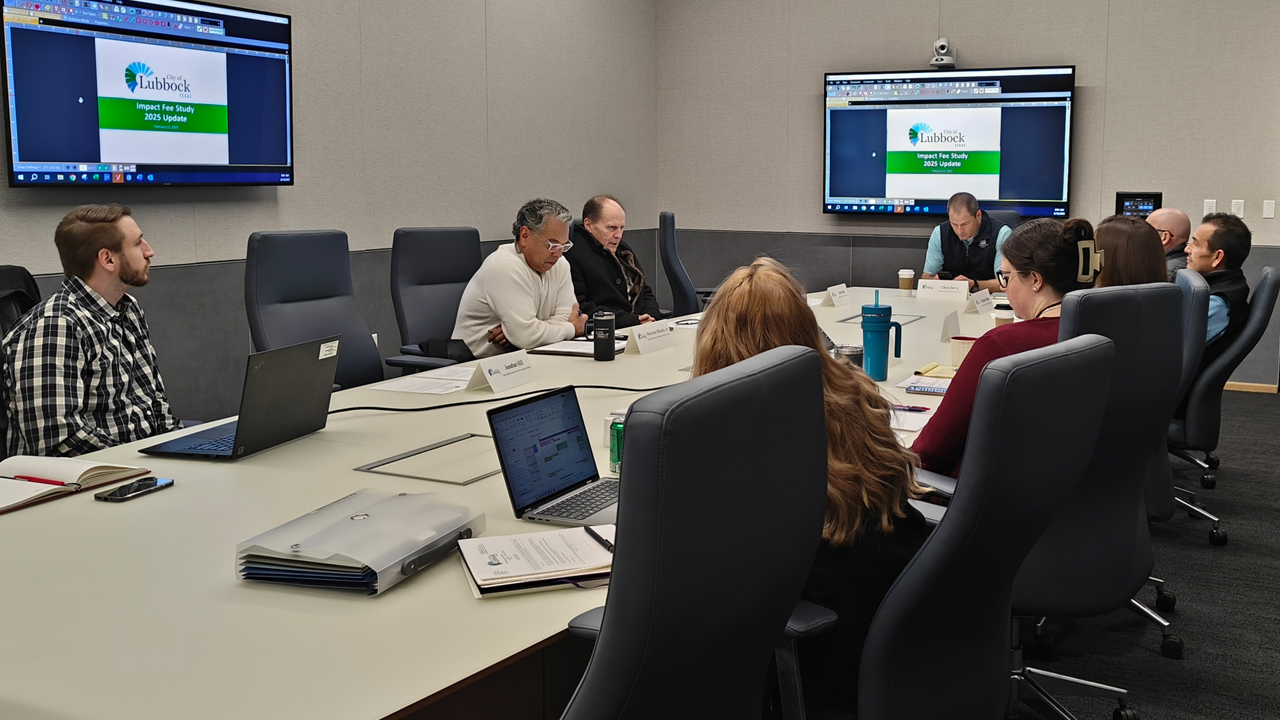Home construction in Northwest Lubbock, Staff photo.
In the next ten years, Lubbock is expected to add 25,000-33,000 new homes, according to city estimates.
Who will pay for roads going to those homes is under debate – culminating in June when the City Council considers changing the current ordinance on developer impact fees.
Developers Thomas Payne and Jordan Wheatley agree Lubbock desperately needs new roads and there’s not enough money to get them built.
Payne, a member of the city’s Capital Improvements Advisory Committee (CIAC), supports impact fees to pay for roads to help him develop new property. He or his customers pay them.
“The point of impact fees is – simply put – for new development to pay for new development,” Payne said.
The CIAC will recommend to the City Council what to do with impact fees in advance of the council’s June meeting. Payne thinks the city should have charged higher fees when the program was first set up.

From June 2021 through December 2024 (three-and-a-half years), Lubbock collected $10.8 million – not enough to pay for hundreds of millions worth of road projects, both Payne and Wheatley agree. But it does offset the cost, according to what John Turpin, city engineer, said during a council meeting this year.
Turpin and City Manager Jarrett Atkinson said impact fees rescued Upland Avenue improvements because the city needed a 20 percent local match on use-it-or-lose-it federal funding.
Previous coverage: Builders not fond of impact fees for new Lubbock roads, but mayor wants to know what would replace them
It’s not worth it, Wheatley said.
“I’ve been a part of advocating against impact fees since the very beginning. I’m a past president of the West Texas Home Builders Association and our mission there always has been to try to maintain affordable housing and keep pricing for new homes as low as possible,” Wheatley said.
Fees could stop some people from becoming first-time homeowners and don’t come close to raising the dollars Lubbock will need for miles of roads, he said.
“Sure, a million-dollar house – that owner’s not even blinking at that. But where this hurts is the lowest-priced housing – the entry level housing. And that’s what we’re trying to protect is the new, very first-time home buyer,” Wheatley said.
The only way forward is a long-term plan to conduct road bond elections, he said.
Developer agreements are another option for some road projects and we’ll explain that further in this story.
Impact fees explained
The city website described impact fees as a one-time payment to cover the “fair share” of costs to extend services like new roads.
Under the current ordinance, someone in far West Lubbock might expect to pay a roughly $1,300 impact fee for a new home. That’s neither the highest nor lowest in Lubbock.
The city adopted impact fees in 2020 at 25 percent instead of the 50 percent allowed under state law. Even if the city keeps collecting at the lower percentage, the fees still need to be updated, generally speaking, every five years to consider things like the cost of road construction, which sets that June deadline for the council.
The current update could double the fees, but nothing has been officially presented to the City Council.
Further behind
During a recent public meeting of the CIAC, Payne said, “If we don’t do something to stop falling further behind, we’re going to keep falling further behind.”
Even with impact fees and two bond issues worth more than $300 million combined, Lubbock is not building roads fast enough, Payne said.
“The problem is that these projects have gotten much more expensive. So, for example, the 2022 bond projects are probably 70 percent more expensive today than they were at the time of that vote,” Payne said.
“From a dollar value standpoint, we are in much worse shape. We’re getting further behind. As the old saying goes, the faster we go, the behinder we get,” Payne told LubbockLights.com
Updating the fees to reflect higher road costs is one part. But Payne thinks Lubbock should have charged the full amount when it adopted impact fees (50 percent instead of 25 percent).
The city could, by law, charge impact fees for water and sewer lines too. But it doesn’t.
“This is a zero-sum game. So, the city side went … from a one-to-one match to a three-to-one match,” Payne said of the difference of doing 25 percent instead of 50 percent.
It’s just not enough money, Payne said.
We won’t know until further in the process if Payne will officially call for the CIAC to propose higher fees. But Payne’s overall position in support of the fees has not persuaded Wheatley.
What is the Capital Improvements Advisory Committee?
The CIAC helps the city conduct impact fee studies and recommends how much to charge in impact fees. The CIAC also establishes a 10-year capital improvement plan and recommends land use assumptions.
Pricing people out of homes
“There’s a stat somewhere that says every $1,000 a house goes up, it prices out X amount of home buyers,” Wheatley said.
According to www.nahb.org, “A $1,000 increase in the price of that median-priced new home will further price 115,593 U.S. households out of the market.”
It’s based on 6.5 percent interest and a median price of nearly $460,000.
If that same math holds true for Lubbock County, then 111 households might be priced out of the market for every $1,000 increase in home prices, according to our calculation.
“A Zone A single family house is $1,303.83. There are lesser fees if it is a townhome or duplex. The real kicker and wildcard are commercial projects. I’ve seen some commercial projects with impact fees above $150,000,” Wheatley said.
The fee hurts new home construction without providing the benefit of new roads, Wheatley said.
“They used a little bit of impact fees to couple with other forms of payment to do a small road [19th Street near the East Loop] out in East Lubbock for the cheese plant. … They’re not able to gather any enough money to even do one project that was on the [2022] road bond,” Wheatley said.
And it’s expensive, he said. For example, the current study for updated fees cost the city $289,000.
“In my view, they’re just wasting time and energy towards impact fees. … The impact fee program has zero real projects completed,” Wheatley said.
“I think we need about another $700 million to keep up on all the roads,” Wheatley said.
Even if the fees doubled, it would not get the roads built. Only road bonds can generate that kind of cash, he said.
In our previous coverage, LubbockLights.com spoke with Joshua Shankles at Lubbock Compact. For him, it was a matter of basic fairness with new development paying its own way – freeing up money the city can use in older parts of town.
In response, Wheatley said, “It’s a good question that he’s asking.”
But ultimately if Lubbock wants to keep property taxes low, then the only source of additional property tax money is new construction, Wheatley said.
Population and new home projections
The CIAC forecasts future growth of roughly 2.2 percent per year in Lubbock over the next 10 years. That would be 67,600 more people according to the CIAC draft documents with 28,523 new homes, based on 2.37 persons per household on average.
If the forecast were at the low end, a 2 percent increase, the CIAC would plan for 60,806 more people in 10 years and 25,657 new homes. The high end, 2.5 percent, would mean 78,532 new people in 10 years and 33,136 new homes.
Better deals with developer’s agreements
In the April 1 meeting of the CIAC, there was a discussion of how to get more roads with less money. One idea is a developer’s agreement.
As one example, Payne got construction started on Quaker Avenue between 146th Street and Woodrow Road. Payne spent his own money for 70 percent of the cost with the city picking up the remaining 30 percent. And the city gave him impact-fee credit for his 70 percent.
Turpin said in the meeting, “Somebody was willing to reveal to us what two lanes of a project will be for them on the private side It’s a quite bit cheaper, ultimately, if y’all build it instead of us.”
Directing his comment to developers in the room, Turpin added, “It’s not that I want to push that on you guys. It’s just that whenever I hear that … the money goes a lot further.”
As for why contractors charge more to the cities, CIAC chairman Chris Berry said in the meeting, “They know all the cities need all these CIP [capital improvement] projects because they’re years behind.”
A city contractor also has higher requirements in state law for insurance and bonding. Turpin pointed out there’s a contractor shortage statewide, not just Lubbock.
“If a developer is willing to partner with us, we can leverage our money to make everything go a lot further than what it would otherwise. And that’s where I think these impact fees are assisting us to do that,” Turpin said.
Clarification: Thomas Payne has taken a stand concerning higher fees in the past. But he has not yet officially taken a stand on updating the fee structure this year. The story was edited to reflect this distinction.
Please click here to support Lubbock Lights.
Comment, react or share on our Facebook post.


 Facebook
Facebook